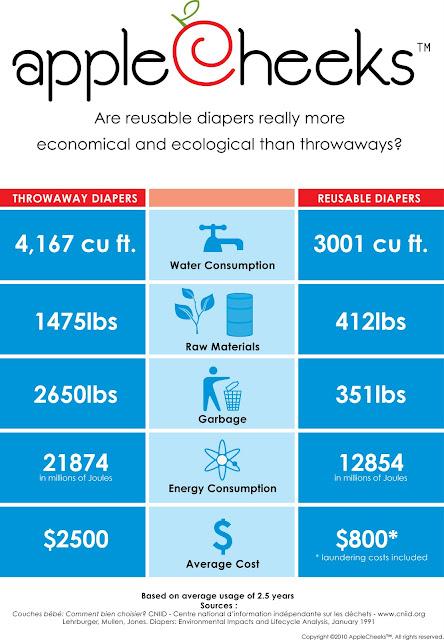Welcome to another
Marky Baby Monday (well, belated Monday)!

From the Desk of Marky Baby -
Why did I switch to cloth? Hmmm. Good question.
Presenting the 'Top Four Reasons I Switched to Cloth.'
4. Cost Savings
3. Environmental Impact
2. Fashion
1. It makes Abby happy! (Editor's note - awwwwwww)
So we all know cloth saves money. I knew it, but not really until I did the math myself. You can break those apples down as far as you want - a two or three year total savings, or a monthly savings, or even a per-change savings. No matter how you slice it, you need to find a number that sells either you or your other half. Just remember, for your partnership you are already convinced, but your partner may not be. Since I'm a bottom-line-numbers guy, all the possible cost-savings scenarios work for me. In fact, the initial cloth naysayers at my office got an earful of the following phrases:
- 'Guess who saved $3 yesterday? Not you.'
- 'Guess who saved some landfill space yesterday? Me!'
- 'Do you really own jean diapers? I have sushi ones!'
But seriously, Abby and I work very hard for our money, why would we let Avalee poo on it and then throw it away? This is an investment. Plain and simple. You buy them, use them while saving money, and you typically can sell them when you are done. Or, if you are Abby, when you find a prettier one. (Editor's note - true fact!)
As the proud owner of a worm composter, I obviously care about the environment. We recycle, carpool, walk when we can, use fluorescent lights and do not own an SUV - why would we throw away diapers that have an estimated landfill shelf life of 500 years or so? Not sure. Some people may argue that disposable diapers are more eco-friendly than washing diapers over and over, but I am pretty sure those are the same people who said the world was flat.
Ok, so the boring part is over. Money and the environment, as important as they may be, don't hold a candle to the fashion. Solid, prints and patterns - oh my! You have different clothes for different uses, and you also need different diapers for different reasons. Think about how cute your baby is dressed. I can imagine it now - a cute dress from Gymboree just below the knee, with a gorgeous flower print in a color scheme that brings out your little girl's eyes. Then styled up with some Robeez and maybe a purse? Who knows. Then your beautiful girl rolls on the ground, playing with the dog.
Bam. There is Winnie the Pooh, and Piglet too, just looking at you from their crinkly paper background.
Talk about ruining the moment!...like when your shoes don't go with your purse (or belt). Why not have coordinating diapers for your little one's outfits? You do it up with baby legs or shoes, why not diapers? You may as well. So break out the kitten heels (after all, you have a little one and cannot exactly chase them in stilettos) and let's accessorize. (Editor's note - is the chasing in stillettos a challenge? I accept!)
The last and final reason is simply that Abby really wanted to do cloth. That's all the reason I needed. All the other stuff was just fluff. Money is always good to save and the environment is cool and fashion is fun, but in this partnership we call a marriage, Abby had something she wanted and it was my job to sell myself.




